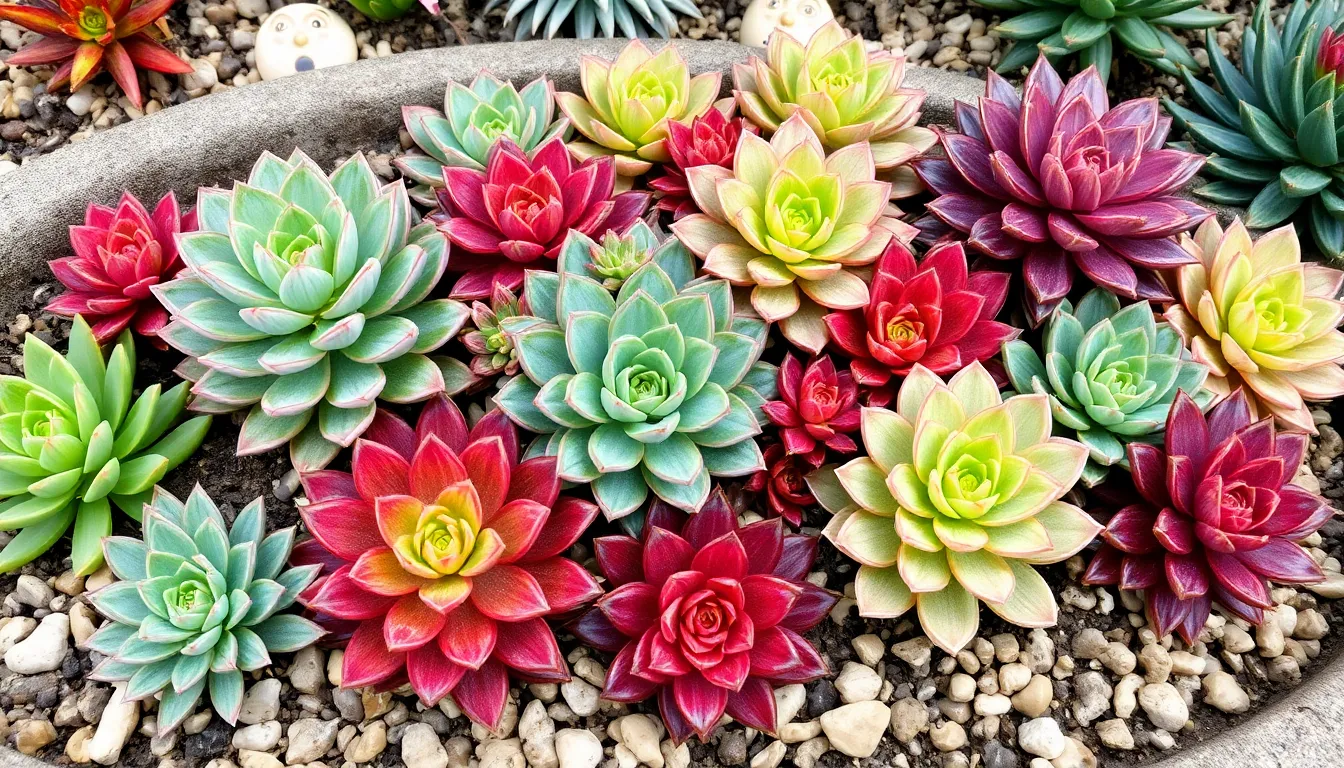Sempervivum succulents, often known as houseleeks, are the quirky little green superheroes of the plant world. With their rosette shapes and vibrant colors, they’re the perfect addition to any home or garden, bringing a touch of charm and a sprinkle of personality. These low-maintenance wonders thrive on neglect, making them ideal for anyone who’s ever accidentally killed a cactus (we won’t tell).
Sempervivum Succulents
Sempervivum succulents, also known as houseleeks, belong to the Crassulaceae family. These plants thrive in various environments, making them ideal for home gardens. They exhibit distinctive rosette forms with colors ranging from deep green to vibrant red, attracting gardeners and plant enthusiasts alike.
These succulents require minimal watering and can tolerate drought, providing a low-maintenance option for busy individuals. With a variety of species available, gardeners can find shapes, sizes, and colors to fit any aesthetic. Sun exposure improves their growth; thus, placing them in bright, sunny locations enhances their natural beauty.
Sempervivum also propagates easily, allowing homeowners to create new plants from existing ones. The process involves separating offsets from the main plant, promoting a fuller appearance in arrangements. This feature contributes to their popularity among both novice and experienced gardeners.
These hardy plants prefer well-draining soil, ensuring that excess moisture does not lead to rot. They excel in rock gardens, containers, and even hanging arrangements, providing adaptability in landscaping. Furthermore, Sempervivum succulents bring unique texture and contrast to garden designs.
While resilient, they can be susceptible to pests such as aphids and mealybugs. Regularly inspecting the plants helps in early detection and management. Overall, the charm and resilience of Sempervivum succulents make them a favored option for cultivating greenery indoors and outdoors.
Types of Sempervivum Succulents

Sempervivum succulents encompass a variety of species, each with distinct features. Recognizing the popular varieties and their unique characteristics helps gardeners choose the right plants for their gardens.
Popular Varieties
Several popular varieties of Sempervivum thrive in different environments. Sempervivum tectorum stands out for its hardiness, making it a common choice in many gardens. Sempervivum arachnoideum, known as cobweb houseleek, features delicate webbing between its leaves, creating a striking visual. Sempervivum ‘Red Rubin’ attracts attention with its deep red coloration, perfect for adding contrast to green foliage. Sempervivum ‘Georgia Peach’ showcases a soft peach hue, providing a lovely pastel option. Each variety adapts well to various conditions, offering options for diverse gardening styles.
Unique Characteristics
Distinctive characteristics define Sempervivum succulents, ensuring they capture interest. Rosette shapes form the centerpiece of each plant, with sizes ranging from tiny to large. Colors vary significantly, including greens, reds, and purples, often changing with the seasons or sunlight exposure. Textures also differ, with some plants exhibiting smooth leaves while others develop unique fuzz or hair. These succulents propagate easily through offsets, allowing gardeners to multiply their collection effortlessly. Each variety exhibits resilience against drought and poor soil, making them favorites among novice and experienced gardeners alike.
Growing Sempervivum Succulents
Growing Sempervivum succulents involves understanding their environmental needs and proper care. These hardy plants thrive in various conditions, making them suitable for many gardeners.
Ideal Climate and Soil Conditions
Sempervivum succulents prefer a well-drained soil mix, typically composed of potting soil combined with sand or perlite. A pH level between 6.0 and 7.0 optimizes their growth. Bright, direct sunlight enhances their color and shape, requiring at least six hours of light daily. While tolerant of cold temperatures, these plants flourish in USDA hardiness zones 3 to 9, making them versatile for many regions. Consistent airflow is crucial to prevent rot. Avoid heavy or compacted soils to ensure drainage is optimal for healthy root development.
Watering and Care Tips
Watering Sempervivum succulents requires a strategic approach. During the growing season, typically spring and summer, thorough watering once every two weeks suffices. Soil should dry out completely between waterings to prevent root rot. Reduce frequency during fall and winter when the plant’s growth slows down. Inspect the plants regularly for pests like aphids and mealybugs. Quick treatment with insecticidal soap or neem oil can manage these issues effectively. Fertilizing once a month with a diluted succulent fertilizer during the growing season promotes robust growth and vibrant color.
Propagating Sempervivum Succulents
Propagating Sempervivum succulents is straightforward and rewarding. Gardeners typically separate offsets for propagation. Offsets, also known as chicks, form around the base of the main plant. They can be gently pulled away with minimal disturbance. Another method is leaf propagation by taking healthy leaves and placing them on well-draining soil. This process encourages new plants to grow from the leaf base.
Methods of Propagation
Dividing offsets ranks among the simplest propagation techniques. Cutting leaves provides an alternative, though success rates may vary. Placing seeds directly in well-draining soil presents another option. Each method offers unique benefits, appealing to different preferences among garden enthusiasts.
Timing and Best Practices
Timing plays a crucial role in successful propagation. Spring is the optimal season for dividing offsets and cutting leaves. Ensuring a dry period before placing cuttings in soil reduces rotting risks. Providing bright, indirect sunlight supports healthy growth of new plants. Regularly checking moisture levels helps maintain ideal conditions.
Conclusion
Sempervivum succulents stand out as a remarkable choice for any plant lover. Their vibrant colors and unique forms not only enhance aesthetic appeal but also offer a low-maintenance option for busy lifestyles. With their adaptability to various environments and ease of propagation, these hardy plants can thrive in both indoor and outdoor settings.
Whether one is a novice gardener or an experienced enthusiast, Sempervivum succulents provide endless possibilities for creative landscaping. Regular care and attention to their specific needs can lead to a thriving collection that brings joy and life to any space. Embracing these resilient beauties can transform a garden into a stunning showcase of nature’s artistry.





